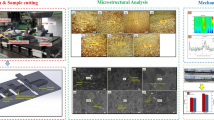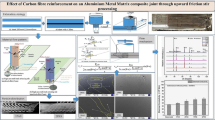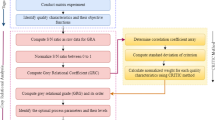Abstract
Aluminum alloy based metal matrix composites are widely used in different engineering applications that are subjected to dynamic loading conditions. In the present study, aluminum alloy Al-Si7Cu3Mn0.5(LM27) composites are manufactured by a stir casting route with two different weight percentages and different size of SiC and TiO2. The reinforcement particles of 15 µm and 115 µm sizes are reinforced in a concentration of 3wt. % and 12wt. %. Split Hopkinson pressure bar is used to evaluate dynamic compressive behavior of the composites at the strain rate of 700, 1500 and 2500 s−1. Microstrucutral examination of fine size reinforced composites exhibited the formation of globular silicon that is arranged around the particles. Micro-hardness of the particle–matrix interface of the fine particle reinforced composite is higher in comparison to composite reinforced with coarse particles. At the strain rate of 700 s−1, at higher concentration of reinforcement particles the fine particles reinforced composites exhibit maximum strength whereas lower concentration of fine particle reinforced composite showed the maximum strain. Strain sensitivity is exhibited by all the composites and strength shows an increasing trend with an increase in the strain rate. The fine particles reinforced composites exhibited maximum flow stress at higher weight percent of reinforcement particles whereas maximum strain is found at lower weight percent of fine particles. The dynamic compressive behavior of composite is found dependent on the degradation of elastic modulus, stress localization phenomena and debonding characteristics.
Similar content being viewed by others
Data Availability
The datasets generated during and/or analysed during the current study are available from the corresponding author on reasonable request.
References
Arivu Y, Uvaraja VC, Thiyaneshwaran N, Ram Prabhu T (2023) Synthesis, processing and phase analysis of quasi crystal particle reinforced aluminium matrix composite. Mater Manuf Processes 38(9):1081–1092. https://doi.org/10.1080/10426914.2022.2146721
Parikh VK, Badheka VJ, Badgujar AD, Ghetiya ND (2021) Fabrication and processing of aluminum alloy metal matrix composites. Mater Manuf Process 36(14):1604–1617. https://doi.org/10.1080/10426914.2021.1914848
Singla YK, Chhibber R, Avdesh, Goyal S, Sharma V (2018) Influence of single and dual particle reinforcements on the corrosion behavior of aluminum alloy based composites. Proceedings of the Institution of Mechanical Engineers, Part L: Journal of Materials: Design and Applications 232(6): 520-532. https://doi.org/10.1177/1464420716638111
Suthar J, Patel KM (2018) Processing issues, machining, and applications of aluminum metal matrix composites. Mater Manuf Processes 33(5):499–527. https://doi.org/10.1080/10426914.2017.1401713
Sharma V, Kumar PS, Pandey OP (2012) Correlation of Reinforced Ceramicparticle’s Nature and Size with Microstructure and Wear Behavior of Al-Si Alloy Composite. In Advanced Materials Research (Vol. 585, pp. 564–568). Trans Tech Publications, Ltd. https://doi.org/10.4028/www.scientific.net/amr.585.564
Rahmat M (2019) Dynamic mechanical characterization of aluminum: Analysis of strain-rate-dependent behavior. Mech Time-Dependent Mater 23(4):385–405. https://doi.org/10.1007/s11043-018-9393-0
Georgievich Shmorgun V, Igorevich Bogdanov A, Pavlovich Kulevich V, Olegovich Taube A (2023) Experimental research of the explosive welding of metal plates with different initial hardness. Materials and Manufacturing Processes 1–10. https://doi.org/10.1080/10426914.2023.2187841
Abdollahzadeh A, Bagheri B, Shamsipur A (2022) Development of Al/Cu/SiC bimetallic nano-composite by friction stir spot welding. Materials and Manufacturing Processes 1–10. https://doi.org/10.1080/10426914.2022.2157435
Dewang Y, Sharma V (2023) Sheet metal shrink flanging process: a critical review of current scenario and future prospects. Mater Manuf Process 1–30. https://doi.org/10.1080/10426914.2022.2149779
Fu D, Ling Y, Jiang P, Sun Y, Yuan C, Du X (2023) Dynamic compressive properties of aluminium-matrix composites reinforced with SiC particles. Mater Technol 57(2):201–207. https://doi.org/10.17222/mit.2022.580
Zhang DD, He XY, Liu Y, Li Gao Y, Geng R (2022) Nanoparticles reinforced Al-matrix composites fabricated by combination of pre-distribution and deformation: a review. Mater Sci Technol 38(13):883–901. https://doi.org/10.1080/02670836.2022.2068272
Kumar S, Panwar RS, Pandey OP, Nagpal PK, Sharma V (2023) High velocity ballistic performance of ZrSiO4 reinforced aluminum alloy matrix composites. Mater Today Commun 106349. https://doi.org/10.1016/j.mtcomm.2023.106349
Armstrong RW, Walley SM (2008) High strain rate properties of metals and alloys. Int Mater Rev 53(3):105–128. https://doi.org/10.1179/174328008X277795
Taniguchi N, Nishiwaki T, Kawada H (2005) Evaluating the mechanical properties of a CFRP tube under a lateral impact load using the split Hopkinson bar. Adv Compos Mater 14(3):263–276. https://doi.org/10.1163/1568551054922601
Farah S, Li F, Zahid HM et al (2023) Deformation Behavior and Plastic Instability of Ultra-High Strength Low Alloy Steel over Wide Temperature and Velocity Range. J Mater Eng Perform. https://doi.org/10.1007/s11665-023-08145-4
Chen H, Wang W, Nie H, Zhou J, Li Y, Zhang P (2018) The dynamic properties of B4C/6061Al neutron absorber composites fabricated by power metallurgy. Mater Sci Technol 34(5):504–512. https://doi.org/10.1080/02670836.2017.1410356
Nemati J, Toosian M, Banisdar SS, Ahmadpour SM (2019) Compressive quasistatic and dynamic behavior of SiC/ZrO 2 aluminum-based nanocomposite. J Mech Sci Technol 33(8):3905–3911. https://doi.org/10.1007/s12206-019-0734-y
Wang X, Jiang F, Zhang T, Wang L (2020) Study on dynamic mechanical properties and constitutive model of 10B/Al composite compared with its matrix of high-purity aluminum. J Mater Sci 55(2):748–761. https://doi.org/10.1007/s10853-019-03949-z
Bao G, Lin Z (1996) High strain rate deformation in particle reinforced metal matrix composites. Acta Mater 44(3):1011–1019. https://doi.org/10.1016/1359-6454(95)00236-7
Vaidya RU, Song SG, Zurek AK, Gray III GT (1996) The effect of structural defects in SiC particles on the static & dynamic mechanical response of a 15 volume percent SiC/6061-Al matrix composite. In AIP Conference Proceedings (Vol. 370, No. 1, pp. 643–646) Am Inst Phys. https://doi.org/10.1063/1.50640
San Marchi C, Cao F, Kouzeli M, Mortensen A (2002) Quasistatic and dynamic compression of aluminum-oxide particle reinforced pure aluminum. Mater Sci Eng, A 337(1–2):202–211. https://doi.org/10.1016/S0921-5093(02)00035-7
Zaiemyekeh Z, Liaghat GH, Ahmadi H, Khan MK, Razmkhah O (2019) Effect of strain rate on deformation behavior of aluminum matrix composites with Al2O3 nanoparticles. Mater Sci Eng, A 753:276–284. https://doi.org/10.1016/j.msea.2019.03.052
Chen Y, Guo YB, Gupta M, Shim VPW (2016) A study of the dynamic compressive response of AZ31/Al2O3 nanocomposites and the influence of nanoparticles. Int J Impact Eng 89:114–123. https://doi.org/10.1016/j.ijimpeng.2015.11.011
Liu H, Zhao Z, Zhang D, Zhang J (2021) Mechanical property and microstructure evolution of novel Al–Mg–Zn (–Cu) alloys under dynamic impact. Mater Sci Technol 37(9):852–862. https://doi.org/10.1080/02670836.2021.1960554
Lee H, Choi JH, Jo MC, Jo I, Lee SK, Lee S (2018) Effects of Strain Rate on Compressive Properties in Bimodal 7075 Al–SiC p Composite. Met Mater Int 24:894–903. https://doi.org/10.1007/s12540-018-0092-9
Panowicz R, Janiszewski J, Kochanowski K (2019) Effects of sample geometry imperfections on the results of split Hopkinson pressure bar experiments. Exp Tech 43:397–403. https://doi.org/10.1007/s40799-018-0293-7
Naghdabadi R, Ashrafi MJ, Arghavani J (2012) Experimental and numerical investigation of pulse-shaped split Hopkinson pressure bar test. Mater Sci Eng, A 539:285–293. https://doi.org/10.1016/j.msea.2012.01.095
Gerlach R, Kettenbeil C, Petrinic N (2012) A new split Hopkinson tensile bar design. Int J Impact Eng 50:63–67. https://doi.org/10.1016/j.ijimpeng.2012.08.004
Mancini E, Sasso M, Rossi M, Chiappini G, Newaz G, Amodio D (2015) Design of an innovative system for wave generation in direct tension–compression split Hopkinson bar. J Dyn Behav Mater 1:201–213. https://doi.org/10.1007/s40870-015-0019-1
Shin H, Kim JB (2019) Evolution of specimen strain rate in split Hopkinson bar test. Proc Inst Mech Eng C J Mech Eng Sci 233(13):4667–4687. https://doi.org/10.1177/0954406218813386
Wang R, Guo W, Liu L, Yuan K, Wang J, Zhao S, Chen L (2023) Simultaneously improved strength and ductility in aluminum matrix composite with heterogeneous structures under impact loadings. J Market Res 23:191–208. https://doi.org/10.1016/j.jmrt.2022.12.187
Acknowledgements
The authors are grateful to Ritu Singla, Chairman and Managing Director of Winner Nippon Leatherette Pvt Ltd., a unit of the Raglan Group, for providing various support for this study within our R&D laboratory.
Funding
The authors declare that no funds, grants, or other support were received during the preparation of this manuscript.
Author information
Authors and Affiliations
Contributions
S.K., N.M., P.C. and V.S. performed the data collection and analysis, S.K. and V.S. wrote the main manuscript text. All authors reviewed the manuscript.
Corresponding author
Ethics declarations
Consent for Publication
All authors agreed with the content and that all gave explicit consent to submit and that they obtained consent from the responsible authorities at the institute/organization where the work has been carried out, before the work is submitted.
Competing Interests
The authors declare no competing interests.
Additional information
Publisher's Note
Springer Nature remains neutral with regard to jurisdictional claims in published maps and institutional affiliations.
Rights and permissions
Springer Nature or its licensor (e.g. a society or other partner) holds exclusive rights to this article under a publishing agreement with the author(s) or other rightsholder(s); author self-archiving of the accepted manuscript version of this article is solely governed by the terms of such publishing agreement and applicable law.
About this article
Cite this article
Kumar, S., Malik, N., Cinelli, P. et al. High Strain Rate Behavior of Stir Cast Hybrid Al-Si Matrix Composites Using Split Hopkinson Pressure Bar. Silicon 16, 231–240 (2024). https://doi.org/10.1007/s12633-023-02680-4
Received:
Accepted:
Published:
Issue Date:
DOI: https://doi.org/10.1007/s12633-023-02680-4




